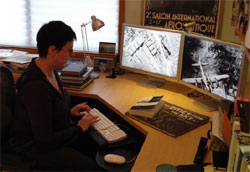Professor of Women and Gender Studies, Cultural Studies Graduate Group, UC Davis
 The product of interdisciplinary initiatives in higher education in the U.S. in the 1970’s and 80’s, Caren Kaplan studied gender and legal philosophy as an undergraduate at Hampshire College and postcolonial studies of travel and displacement in the PhD program in History of Consciousness at UC Santa Cruz. She has critiqued neo-colonial discourses of mobility in feminist studies and other academic fields–work that resulted in several essays, articles and the monograph Questions of Travel: Postmodern Discourses of Displacement (Duke 1996). With long-time collaborator Inderpal Grewal, she has written numerous articles and co-edited Scattered Hegemonies: Postmodernity and Transnational Feminist Practices (Minnesota 1994) and Introduction to Women’s Studies: Gender in a Transnational World (McGraw-Hill 2001, 2005). She has also co-edited Between Woman and Nation: Transnational Feminisms and the State (Duke 1999) with Norma Alarcon and Minoo Moallem. Her current research focuses on militarization, transnational consumer culture, and location technologies including published articles on mobility and air power and the consumer subjects of the first U.S. Persian Gulf war. Her first multimedia piece, created with Reagan Kelly, “Dead Reckoning: Vision, Mobility, and the Social Construction of Targets,” has been published in Vectors 2:2 (2007). Her forthcoming book, Transporting the Subject: U.S. Technoscience, Militarization, and Cosmopolitan Modernities (Duke 2008) inquires specifically into the emergence of modes of seeing following the rise of aviation and aerial perspective in military and civilian culture in the 20th and 21st centuries. In 2006-07 she is recipient of an inaugural ACLS Digital Innovation research fellowship and she is working on a new multimedia piece on contemporary wars and location technologies.
The product of interdisciplinary initiatives in higher education in the U.S. in the 1970’s and 80’s, Caren Kaplan studied gender and legal philosophy as an undergraduate at Hampshire College and postcolonial studies of travel and displacement in the PhD program in History of Consciousness at UC Santa Cruz. She has critiqued neo-colonial discourses of mobility in feminist studies and other academic fields–work that resulted in several essays, articles and the monograph Questions of Travel: Postmodern Discourses of Displacement (Duke 1996). With long-time collaborator Inderpal Grewal, she has written numerous articles and co-edited Scattered Hegemonies: Postmodernity and Transnational Feminist Practices (Minnesota 1994) and Introduction to Women’s Studies: Gender in a Transnational World (McGraw-Hill 2001, 2005). She has also co-edited Between Woman and Nation: Transnational Feminisms and the State (Duke 1999) with Norma Alarcon and Minoo Moallem. Her current research focuses on militarization, transnational consumer culture, and location technologies including published articles on mobility and air power and the consumer subjects of the first U.S. Persian Gulf war. Her first multimedia piece, created with Reagan Kelly, “Dead Reckoning: Vision, Mobility, and the Social Construction of Targets,” has been published in Vectors 2:2 (2007). Her forthcoming book, Transporting the Subject: U.S. Technoscience, Militarization, and Cosmopolitan Modernities (Duke 2008) inquires specifically into the emergence of modes of seeing following the rise of aviation and aerial perspective in military and civilian culture in the 20th and 21st centuries. In 2006-07 she is recipient of an inaugural ACLS Digital Innovation research fellowship and she is working on a new multimedia piece on contemporary wars and location technologies.
Professor Kaplan has been engaged in program building in new media and technology studies for some time. At UC Berkeley she co-founded the Berkeley Center for Globalization and Information Technology (2000-03) and she was affiliated faculty in the New Media Initiative. At UC Davis, she has co-founded the Davis Humanities Institute Research Cluster in “Technology, Culture, and the Arts” and the Center for Research on Women in “Technovisual Cultures: Feminism and New Media Technologies.” The graduate group in Cultural Studies, which she chairs, encourages interdisciplinary studies in technology, new media, and the arts and welcomes applications for the PhD program in those interest areas.
Links: Vectors | Cultural Studies
Quote:
I am inquiring into the conditions that produce new consumer and citizen subjects in relation to historically specific technologies that link geography, demography, remote sensing, and contemporary identity politics (including geopolitics). These subjects can be understood to be the “targets” of two seemingly distinct contexts and practices: the target of a weapon and the target of a marketing campaign. In both cases, something or somebody has to be identified, coordinates have to be determined with available technologies, and the target has to be clearly marked or recognized in time and space. GIS provides the model for data bases as well as the representational logic for both warfare and marketing while GPS offers enhanced precision in locating such targets through accurate positioning. Geographically-based location technologies that draw on discourses of precision make possible the subjects of consumption and war.
 Traditional computer interfaces have very limited input capabilities, typically restricted to keyboard typing and mouse manipulations (pointing, selecting, dragging, etc.). The area of vision-based interaction seeks to provide a wider and more expressive range of input capabilities by using computer vision techniques to process sensor data from one or more cameras in real-time, in order to reliably estimate relevant visual information about the user – i.e., to use vision as a passive, non-intrusive, non-contact input modality for human-computer interaction.
Traditional computer interfaces have very limited input capabilities, typically restricted to keyboard typing and mouse manipulations (pointing, selecting, dragging, etc.). The area of vision-based interaction seeks to provide a wider and more expressive range of input capabilities by using computer vision techniques to process sensor data from one or more cameras in real-time, in order to reliably estimate relevant visual information about the user – i.e., to use vision as a passive, non-intrusive, non-contact input modality for human-computer interaction.
